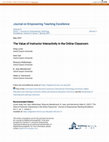Papers by Shaunna Waltemeyer
ELearn magazine, Dec 28, 2018
This paper reviews screencasting software as a means to establish and maintain student engagement... more This paper reviews screencasting software as a means to establish and maintain student engagement and authentic relationships in higher education virtual classrooms. While student engagement is often a challenge with virtual classrooms new technologies are available that allow teachers to provide audio and video feedback to students. Screencasting software can be used for individual feedback, demonstrations, and modeling. The paper concludes with recommendations for future research.

IGI Global eBooks, 2021
For institutions with a strong reliance on campus-based, full-time faculty, there are likely seve... more For institutions with a strong reliance on campus-based, full-time faculty, there are likely several policies and procedures that may hinder morale, motivation, and engagement for remote faculty that should be considered. The purpose of this chapter is to provide key areas of policy that administrators may want to consider in the areas of technology and equipment, faculty and student expectations, barriers to time and geography, and training and development. Key recommendations provided at the end of the chapter include developing a strategy to provide online faculty with the appropriate learning tools to deliver high-quality education via the online modality; creating a comprehensive set of policies and procedures that outline student and faculty expectations and requirements in the online classroom; integrating tools, resources, and policies that set remote faculty up for success; and supporting faculty through coaching, mentoring, and best practices.

Journal on Empowering Teaching Excellence, 2021
As the number of faculty teaching online continues to grow, so has the interest in and understand... more As the number of faculty teaching online continues to grow, so has the interest in and understanding of the role of instructor interaction in the online classroom. Online education provides a unique platform in which course design and teaching are independent factors. Understanding faculty and student perceptions about the shifting role of instructor interaction in the online classroom can provide insight on policies and procedures that can support student learning through student-instructor interaction. Participants included faculty and students responding to an anonymous online survey who indicated "online" as their primary mode of teaching. Three key "value" themes emerged as significantly valuable: instructor interactivity, instructor feedback on participation, and asynchronous interaction in discussion forums. These findings illuminate opportunities and areas of consideration for three stakeholders in the student-teacher interaction equation: faculty, faculty developers, and administrators that can be used to inform quality online teaching through instructor interactivity.

Handbook of Research on Inclusive Development for Remote Adjunct Faculty in Higher Education, 2021
For institutions with a strong reliance on campus-based, full-time faculty, there are likely seve... more For institutions with a strong reliance on campus-based, full-time faculty, there are likely several policies and procedures that may hinder morale, motivation, and engagement for remote faculty that should be considered. The purpose of this chapter is to provide key areas of policy that administrators may want to consider in the areas of technology and equipment, faculty and student expectations, barriers to time and geography, and training and development. Key recommendations provided at the end of the chapter include developing a strategy to provide online faculty with the appropriate learning tools to deliver high-quality education via the online modality; creating a comprehensive set of policies and procedures that outline student and faculty expectations and requirements in the online classroom; integrating tools, resources, and policies that set remote faculty up for success; and supporting faculty through coaching, mentoring, and best practices.
eLearn, 2018
This paper reviews screencasting software as a means to establish and maintain student engagement... more This paper reviews screencasting software as a means to establish and maintain student engagement and authentic relationships in higher education virtual classrooms. While student engagement is often a challenge with virtual classrooms new technologies are available that allow teachers to provide audio and video feedback to students. Screencasting software can be used for individual feedback, demonstrations, and modeling. The paper concludes with recommendations for future research.

The purpose of this qualitative descriptive phenomenological study was to understand how women de... more The purpose of this qualitative descriptive phenomenological study was to understand how women described their lived experiences entering and working in the male-dominated field of motorsports within the United States. Using purposive and snowball sampling, 11 women participated in the study who met the criteria of being at least 18-years of age, currently working in motorsports, and living in the United States. The theoretical foundations that guided this study included social role theory and social cognitive career theory. This study explored two research questions: How do women describe their lived experiences working in the male-dominated field of motorsports? And how do lived experiences of women impact their decision to pursue a career in the male-dominated field of motorsports? Data collection occurred using a series of three separate interviews per participant. Eidetic analysis resulted in nine themes and one sub-theme. Significant themes included required characteristics, i...
Handbook of Research on Creating Meaningful Experiences in Online Courses, 2020
This chapter will outline various best practices to assist instructors in closing the distance fo... more This chapter will outline various best practices to assist instructors in closing the distance for online students. Topics include the theory of transactional distance as well as creating an engaging learning environment and overall student satisfaction. Best practices include live conferencing, instant communication tools, effective feedback, group discussions, announcements and reminders, the ease of using an online learning platform, and establishing personal connections. This chapter also provides examples and practical applications for technology in the online learning environment.










Uploads
Papers by Shaunna Waltemeyer